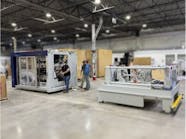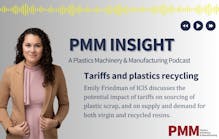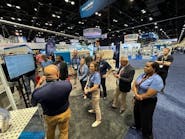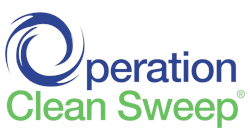By David Tillett
Since 1990, Ensign Equipment has been producing a range of material handling and auxiliary equipment for the recycling, plastics, pharmaceutical and food & beverage industries, among others, and its equipment is installed in plants around the country. But even companies with equipment manufactured by Ensign may not be familiar with their brand. That’s because, until recently, the majority of the company’s equipment went for private label sale by other OEMs and systems integrators.
About 10 years ago, Ensign began its first forays into marketing its brand, mostly with simple paid ads in magazines.
“Marketing of our individual product lines just started in the 2020 time period,” said Andrew Hartline, VP of sales and marketing.
The company has also branched out, adding automation to more of its equipment as well as designing and installing turnkey systems for manufacturers. Its original business model worked for decades — so why make these changes? According to Hartline, “[we’re] trying to make ourselves recession-proof.”
He said that over the years, his company has seen increasing market pressures, with more companies making auxiliary equipment.
Hartline said that while Ensign has long been able to sell customers pieces of equipment necessary to build a cell or system, it can now offer them more value by designing systems, sourcing all the necessary components, handling project management and installation.
“We do a lot of gaylord dumpers, bag unloaders and screw conveyors in the recycling world,” Hartline said. “What happens often is [raw material goes from] a dumper into a power hopper, which is a screw conveyor with a reservoir hopper. And then we’re feeding directly into the feed throat to the extruder.”
One type of equipment that finds favor with plastics recyclers is Ensign’s Typhoon line of high-capacity vertical auger mixers. Its largest model has a capacity of 1,300 cubic feet — allowing it to handle truckload-sized batches of material.
Because it can mix flakes and granules as well as pellets, Hartline said the mixer can handle resins before or after the pelletizing process and homogenize all of the material produced in a shift — or multiple shifts. This avoids production of pellets with melt points that vary gaylord by gaylord. “So, it gives them greater consistency on the product that they’re selling in a larger bulk volume,” Hartline said — and that consistency makes their pellets more valuable.
Ensign can also design cells to match a customer’s specific needs. Using the example of a gaylord fill station, Ensign can provide a very basic manual fill station, or it can introduce smart system capabilities. “Maybe somebody wants to fill gaylords, but they don’t want to have an operator interface with it. We have designed systems that are nearly fully automated on box-out stations.” He said that an operator can set an empty gaylord in place, and from there the system can index it and fill it to a set point. The system keeps track of all data on each box including its weight, then it prints a label and tags the box. Once all those steps are done, an operator is again needed to remove the gaylord.
Hartline said that coming out of the 2008 recession, many companies were forced to downsize their maintenance and engineering teams. Because of the loss of that expertise, more of these companies are looking to buy complete systems rather than handling all aspects of an installation in-house.
“That’s been a huge leveraging point for us in our growth: We tailor fit, and we do it pretty fast,” he said. “So, most of our quotes go out the door within probably 48 hours, maybe 72.”
Hartline said that offering turnkey installations has improved more than just Ensign’s bottom line.
“It’s also [helped] us get better at making better products,” Hartline said. “When you’re working as a subcontractor to other OEMs, you’re a little bit more removed from the end user, so you don’t necessarily get that feedback to help do your product improvement side of things.” Acting as a project lead lets Ensign get input during the design process as well as customer feedback after the equipment is installed. “That continuously helps us on our improvement side of our product line,” he said.
Handling turnkey installations has made Ensign turn to other companies to supply components that it doesn’t manufacture itself, such as vacuum pumps, airlocks and metal separation equipment. “That’s been a tremendous kind of learning curve for us, right, and creating those partnerships in the industry,” Hartline said. “And, you know, it’s been a total company kind of endeavor as you try to get engineering involved and sales involved.”
Ensign has also had to refine its processes to accommodate a new level of customer support.
“When we hand over the full system to the customer, they’ve got a three-ring binder or a thumb drive that’s got not just what we supplied manual-wise, but the manuals for this piece of equipment and this piece of equipment and these motors, and here’s troubleshooting guides, and then we have that on hand as well, so that if there becomes an issue, we can support it,” Hartline said.
Ensign has seen a substantial growth in demand, and with that has come a growing employee roster. “I would say as far as HR, personnel-wise, we’ve more than doubled — I would say closer to tripled in the past three years,” Hartline said.
The company continues to update its established equipment. “We also do little things, just on our basic machinery. All of our pump assemblies on our hydraulic dumpers have gauges and LED lights on manifolds, so that maintenance team can see what pressures they’re pulling, when they’re lifting weights, they can see if the machine is functioning properly, letting the fluid come back down, if they’re actually getting a signal at that valve. We’ve got a team of engineers, and they’re definitely making improvements left and right.”
David Tillett, associate editor
Contact:
Ensign Equipment Inc., Holland, Mich., 616-738-9000, www.ensigneq.com
David Tillett | Associate Editor
Associate Editor David Tillett writes and edits for Plastics Machinery & Manufacturing, Plastics Recycling and The Journal of Blow Molding. He covers new products, industry news, patents and consumer and business equipment. He has more than 20 years of experience in daily newspaper, online and magazine journalism.






